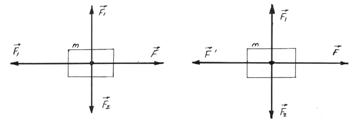
CATEGORIES:
BiologyChemistryConstructionCultureEcologyEconomyElectronicsFinanceGeographyHistoryInformaticsLawMathematicsMechanicsMedicineOtherPedagogyPhilosophyPhysicsPolicyPsychologySociologySportTourism
Mechanical Energy
Let a body be acted upon by a number of forces whose vector sum is equal to zero. The body moves uniformly and rectilinearly. All the forces may than be resolved into four components.

Figure 5.1
 (5.4)
(5.4)
Forces  and
and  in accordance with the adopted definition, perform no work. Force
in accordance with the adopted definition, perform no work. Force  performs work equal to
performs work equal to  where
where  is the traversed distance. The work of force
is the traversed distance. The work of force  is equal to
is equal to  , where the minus sing indicates that work is performed against the force
, where the minus sing indicates that work is performed against the force  .
.
Let us now consider the motion of a body with acceleration (curvilinear and non uniform motion). Now,  is not equal to
is not equal to  , and
, and  is not equal to
is not equal to  . The work of force
. The work of force  is again negative, i.e., the work is performed against the force
is again negative, i.e., the work is performed against the force  and equal
and equal 

The inequality between the forces  and
and  shows that the motion is curvilinear. Their difference
shows that the motion is curvilinear. Their difference  corresponds to the normal component of the acceleration. Let us consider an extreme case – uniform motion in a circle. The resultant force for such motion is directed, as we know, along the radius of the circle, i.e., perpendicular to the direction of motion. Therefore, the centripetal force performs no work.
corresponds to the normal component of the acceleration. Let us consider an extreme case – uniform motion in a circle. The resultant force for such motion is directed, as we know, along the radius of the circle, i.e., perpendicular to the direction of motion. Therefore, the centripetal force performs no work.  is the tangential component of the resultant force
is the tangential component of the resultant force  , and
, and
 (5.5)
(5.5)
The work expended in accelerating a body is equal to the product of the mass of the body, the traversed distance, and the tangential acceleration. The work performed by the force of resistance and the work expended in accelerating the body
 (5.6)
(5.6)
For  , we obtain
, we obtain
 ; (5.7)
; (5.7)
where v is the average velocity, which is equal
 (5.8)
(5.8)
Since  or
or  . In result
. In result  . (5.9)
. (5.9)
Date: 2015-01-12; view: 1457
| <== previous page | | | next page ==> |
| Motion in circle is accelerated motion | | | Kinetic Energy and the Work-Energy Theorem |